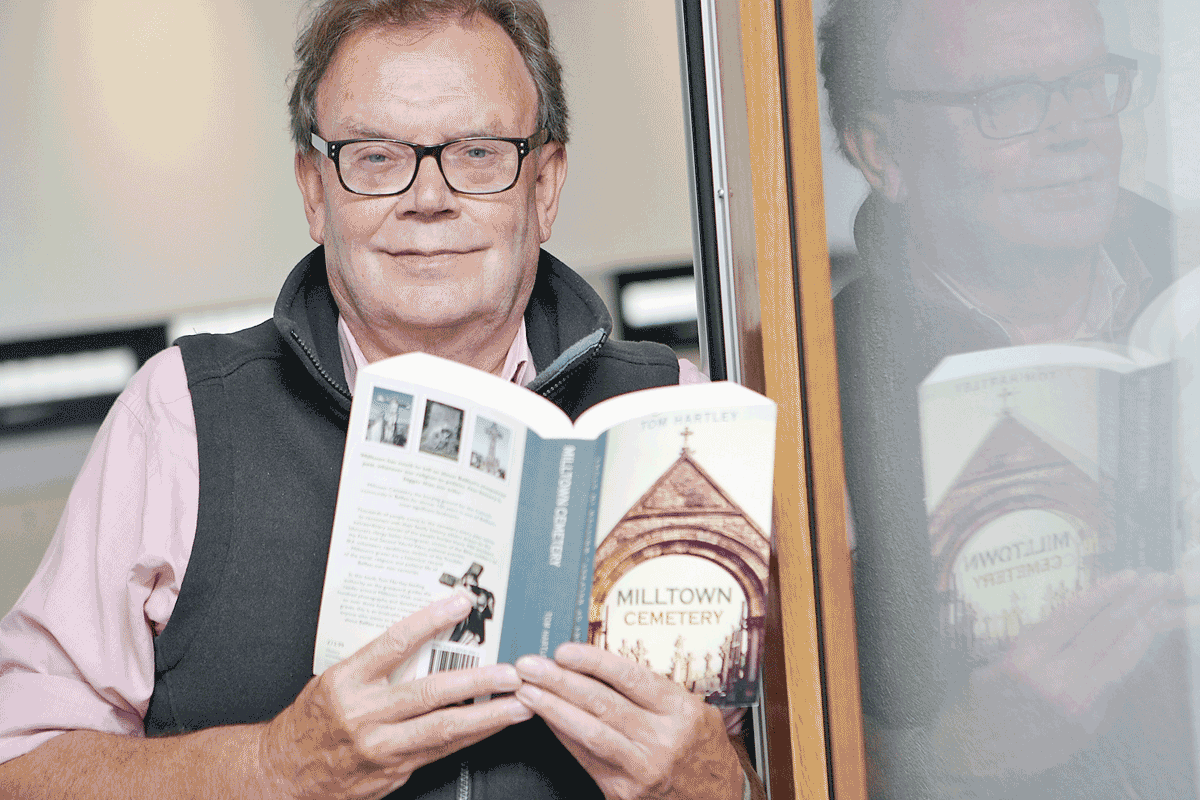DESCRIBING it as “the other half of the story”, Tom Hartley is preparing to launch his new book about Milltown Cemetery. It is the second part of his The History of Belfast, Written In Stone series, the first focusing on the City Cemetery.
The new book will be launched as part of Féile an Phobail next Thursday at St Dominic’s where a new edition of the City Cemetery book will also be unveiled.
We sat down with the author, a former Belfast Lord Mayor, this week for a chat about the fascinating history buried in Milltown.
“This is the other half of the story, the history of Milltown,” he said. “There is no one narrative that can tell the history of Belfast and this book is a reminder of that, as there are so many complexities and layers of history buried in the cemetery.
“The book tries to tell Belfast’s rich, dynamic and troubled history with figures people know and many that are unknown.”
The book offers an engaging reflection on the long and troubled history of the city’s Catholic community as it struggled to establish a foothold in a predominantly Protestant and unionist environment. It also covers the creative contribution that Catholics made in the arts and in the revival of the Irish language. Priests and nuns, architects and footballers, businessmen and poets, hurlers and harp makers, British soldiers and IRA volunteers all feature in the opening chapter in the story.
Giving us a glimpse of what is detailed in the book, Tom talked us through just some of the subjects covered in Milltown Cemetery, the main burying ground for the Catholic community in Belfast for almost 150 years, and one of the city’s most significant landmarks.
“Milltown’s graves are a historical record of the social, religious and political life of Belfast over two centuries,” he explained. “The book really falls into two themes. The first is the political history of the city. The history of the IRA and the IRB in Belfast, those who fought in the Civil War, those who fought for the Free State army, they are all represented in graves at Milltown. There are also memorials to those who fought against Franco and those who fought for Franco, there are British Army graves and Polish war graves.
“Joe McKelvey’s father is buried in a British war grave just 100 yards from the Harbinson Plot where Joe himself is buried. There’s the RIC man William Barrett, who led the RIC strike in 1907, buried there. The first conflict-related death in 1886 was that of James Curran, he is there. So there is a world of political history to be told. Mine isn’t the definitive history of Milltown, but I give it a good go,” he laughed before moving on.
“The second theme is the development of the Catholic Church in the late nineteenth century. Through the burial sites you can see the expansion of the infrastructure of the the Catholic Church in Belfast. There are graves of bishops, priests, nuns and many religious orders, including the Christian Brothers and the Redemptorists, up to and including Fr Alec Reid.
“Those are the main themes, but I also touch on the artists and actors who are buried there, significant individuals in sporting organisations from Belfast Celtic to the GAA and, of course, the poor graves.”
In this book, Tom, a leading authority on the graveyard, guides the reader around Milltown. With over one hundred photographs and detailed entries on over three hundred noteworthy graves, this is an invaluable guide for anyone who wants to know more about Belfast and its people.
There are diagrams, photographs, images of sections of the graveyard and also details of those buried in the Falls Road’s other two burial sites (apart from City Cemetery) – the graveyard at St Dominic’s and the Clonard crypt.
Despite Tom’s modesty, there is no doubting the book is a comprehensive history in 400 pages, the index alone with its list of hundreds of names is testament to that and to the hours Tom put into researching the subject.
“I used my own knowledge of the history of the city and made connections, but I am also told bits and pieces of information that lead me to do some research and then we have a whole new direction,” he said.
“It took about six years to complete the book, much of that time was spent in the cemetery – I couldn’t tell you how long I spent there walking and photographing. But it’s finished and I am looking forward to the launch.”
Since Féile’s inception in 1988, Tom has organised hugely popular tours of West Belfast and the history of its communities as part of the festival programme. This year is no different and Tom will be leading his annual tour of the City Cemetery when the festival kicks off next week.
Also being published by Blackstaff Press alongside this book is a new edition of Tom’s acclaimed The History of Belfast, Written In Stone: Belfast City Cemetery. Within the walls of Belfast City Cemetery lie many of the men and women who shaped the city. From the great and the good to the poor and the destitute, each grave has its own tale to tell. In this new edition of his acclaimed publication, Tom Hartley uses the cemetery to examine key events in Belfast’s history – the First and Second World Wars, the Troubles, the campaign against Home Rule, and the Dockers’ Strike of 1907, as well as the development of shipbuilding and other industries. The careers of the many writers, artists, entertainers and sportsmen who have helped to enhance the city’s international reputation over the years are also touched upon.
The launch takes place at St Dominic’s on Thursday next (July 31) at 6.30pm.






